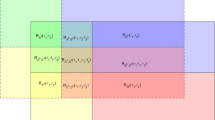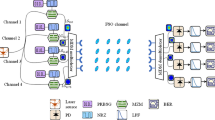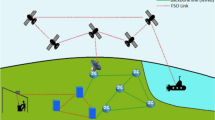Abstract
In this paper, the Spectral Amplitude Coding-Optical Code Division Multiple Access (SAC-OCDMA) system performance is investigated both in Free Space Optics (FSO) and Optical Fiber Systems (OFS) scenarios focusing on different types of codes. The codes having low cross correlation such as Random Diagonal (RD) and Khazani-Syed (KS), and zero cross correlation such as Zero Cross Correlation (ZCC) and Multi-Diagonal (MD) are used. In the FSO scenario, moderate turbulence and hazy weather conditions are considered. In the OFS scenario, nonlinear effects, attenuation, and dispersion are taken into consideration. Also, the performance of various codes is evaluated under different rain attenuation conditions. The simulation results show that the SAC-OCDMA codes performance is media-dependent. The ZCC codes give better performance than low cross correlation codes in both FSO and OFS scenarios. The MD code gives the best code performance in both scenarios with the ZCC code following. The RD code provides better performance than the KS code in the OFS scenario. However, in the FSO scenario, the KS code performs better than the RD code under the turbulence effect. Furthermore, the MD code performance under different bit rates is investigated to support tri-play services. Its security performance is also investigated.











Similar content being viewed by others
References
Dai, Y., Chen, X., Sun, J., et al. (2006). High-performance, high-chipcount optical code division multiple access encoders–decoders based on a reconstruction equivalent-chirp technique. Optics Letters, 31, 1618–1620.
Anas, S. B. A., Abdullah, M. K., Mokhtar, M., et al. (2009). Optical domain service differentiation using spectral-amplitude-coding. Optical Fiber Technology, 15, 26–32.
Fadhil, H. A., Aljunid, S. A., & Ahmad, R. B. (2009). Performance of random diagonal code for OCDMA systems using new spectral direct detection technique. Optical Fiber Technology, 15, 283–289.
Salehi, J. A. (1989). Code division multiple-access techniques in optical fiber networks-part I: Fundamental principles. IEEE Transactions on Communications, 37, 824–833.
Smith, E. D. J., Blaikie, R. J., & Taylor, D. P. (1998). Performance enhancement of spectral-amplitude-coding optical CDMA using pulse-position modulation. IEEE Transactions on Communications, 46, 1176–1185.
Wei, Z. (2002). Unipolar codes with ideal in-phase cross-correlation for spectral amplitude-coding optical CDMA systems. IEEE Transactions on Communications, 50, 1209–1212.
Wei, Z., Shalaby, H. M. H., & Ghafouri-Shiraz, H. (2001). Modified quadratic congruence codes for fiber Bragg-grating-based spectral-amplitude-coding optical CDMA systems. Journal of Lightwave Technology, 19, 1274–1281.
Hasoon, F. N., Aljunid, S. A., Samad, M. D. A., et al. (2008). Spectral amplitude coding OCDMA using AND subtraction technique. Applied Optics, 47, 1263–1268.
Al-Khafaji, H. M. R., Aljunid, S. A., & Fadhil, H. A. (2012). Improved BER based on intensity noise alleviation using developed detection technique for incoherent SAC-OCDMA systems. Journal of Modern Optics, 59, 878–886.
Ahmed, N., Aljunid, S. A., Fadil, A., et al. (2013). Performance enhancement of OCDMA system using NAND detection with modified double weight (MDW) code for optical access network. International Journal for Light and Electron Optics, 124, 1402–1407.
Ahmed, H. Y., & Nisar, K. S. (2013). Diagonal Eigenvalue Unity (DEU) code for spectral amplitude coding-optical code division multiple access. Optical Fiber Technology, 19, 335–347.
Sahbudin, Ratna. Kalos. Zakiah., Kamarulzaman, Mazlin., Hitam, Salasiah., et al. (2013). Performance of SAC OCDMA-FSO Communication Systems. International Journal for Light and Electron Optics, 124, 2868–2870.
Wen, K.-H., Yan, L.-S., Pan, W., et al. (2013). Multi-channel optical code-division multiple-access scheme based on super-structure fiber Bragg gratings. Optik, 124, 2045–2049.
Teh, P. C., Petropoulos, P., Ibsen, M., et al. (2001). A comparative study of the performance of seven and 63-chip optical code-division multiple-access encoders and decoders based on superstructured fiber Bragg gratings. Journal of Light Technology, 19, 1352–1365.
Jazayerifar, M., & Salehi, J. A. (2006). Atmospheric optical CDMA communication systems via optical orthogonal codes. IEEE Transactions on Communications, 54, 1614–1623.
Hamzeh, B., & Kavehrad, M. (2004). OCDMA-coded free-space optical links for wireless optical-mesh networks. IEEE Transactions on Communications, 52, 2165–2174.
Moghaddasi, M., Seyedzadeh, S., & Anas, S. B. A. (2014). Optical code division multiple access codes comparison in free space optics and optical fiber transmission medium. In Region 10 symposium, Kuala Lumpur, Malaysia, April 2014 (pp. 181–184).
Muhammad, S. S, Köhldorfer, P., & Leitgeb, E. (2005). Channel modeling for terrestrial free space optical links. In 7th International conference proceedings of 2005 in transparent optical networks, July 2005, (pp. 407–410).
Willebrand, H., & Ghuman, B. S. (2002). Free-space optics: Enabling optical connectivity in today’s networks (pp. 1–47). Indianapolis: Sams publishing.
Bouchet, Olivier., Sizun, Hervé., Boisrobert, Christian., et al. (2004). Free-space optics propagation and communication. Toulouse: Hermes Science.
Mohammed, H. S., Aljunid, S. A., Fadhil, H. A., et al. (2013). Generation of a new hybrid subcarrier multiplexing–SAC-OCDMA system based on FSO. Journal of Theoretical and Applied Information Technology, 58, 389–396.
Anuar, M. S., Alijunid, S. A., Saad, N. M., et al. (2009). New design of spectral amplitude coding in OCDMA with zero cross-correlation. Optics Communications, 282, 2659–2664.
Anuar, M. S., AlJunid, S. A., Arief, A. R., et al. (2013). PIN versus avalanche photodiode gain optimization in zero cross correlation optical code division multiple access system. Optik, 124, 371–375.
Abd, T. H., Aljunid, S. A., Fadhil, H. A., et al. (2011). Development of a new code family based on SAC-OCDMA system with large cardinality for OCDMA network. Optical Fiber Technology, 17, 273–280.
Bakarman, H. A., Shaari, S., & Ismail, M. (2010). Security and performance tradeoffs in optical CDMA network systems. In International conference on photonics (ICP), Langkawi, July 2010 (pp. 1–4).
Author information
Authors and Affiliations
Corresponding author
Rights and permissions
About this article
Cite this article
Mostafa, S., Mohamed, A.EN.A., El-Samie, F.E.A. et al. Performance Evaluation of SAC-OCDMA System in Free Space Optics and Optical Fiber System Based on Different Types of Codes. Wireless Pers Commun 96, 2843–2861 (2017). https://doi.org/10.1007/s11277-017-4327-8
Published:
Issue Date:
DOI: https://doi.org/10.1007/s11277-017-4327-8




